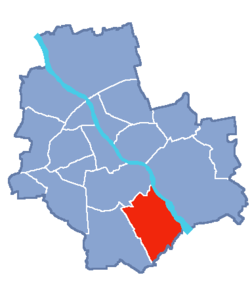Wilanów
| Wilanów | ||
|---|---|---|
| Warsaw District | ||
|
||
 Location of Wilanów within Warsaw |
||
| Coordinates: 52°10′N 21°05′E / 52.167°N 21.083°ECoordinates: 52°10′N 21°05′E / 52.167°N 21.083°E | ||
| Country |
|
|
| Voivodeship | Masovian | |
| County/City | Warsaw | |
| Notable landmarks | Wilanów Palace, Poster Museum, palace park | |
| Government | ||
| • Mayor | Rafał Miastowski | |
| Area | ||
| • Total | 36.73 km2 (14.18 sq mi) | |
| Population (2003) | ||
| • Total | 14,032 | |
| • Density | 380/km2 (990/sq mi) | |
| Time zone | CET (UTC+1) | |
| • Summer (DST) | CEST (UTC+2) | |
| Area code(s) | +48 22 | |
| Website | wilanow.pl | |
Wilanów (Polish pronunciation: [vʲiˈlanuf]) is a district of the city of Warsaw, Poland. It is home to historic Wilanów Palace, the "Polish Versailles," and second home to various Polish kings.
The first mentions of a settlement in the area can be traced to the 13th century, when a village named Milanów was founded by the Benedictine monastery of Płock. In 1338 it became a private property of the Dukes of Mazovia and in 1378 Prince Janusz I of Warsaw gave it to one of his servants. It was he who established the first mansion and a chapel in the village. His descendants adopted the name Milanowski, after the name of the village.
In the 17th century the village was bought by the family of Stanisław Leszczyński, who started the construction of a new palace; however, the works were stopped by The Deluge when the forces of Sweden captured the area and plundered it completely. In 1676 the depopulated village was bought by King Jan III Sobieski. By his order, Tylman van Gameren and Augustyn Wincenty Locci erected the new baroque-style palace and St. Anne's Church. Initially the palace was named Villa Nova (New Village), to distinguish it from the nearby village of Stara Wieś (Old Village). However, soon the name was polonised to Wilanów, similar to the former name Milanów.
Thanks to the proximity of both the kings' summer residence and the city of Warsaw, Wilanów has for ages been a suburb of Warsaw and a popular holiday spot for Polish magnates. It was also the final point on the historical Royal Road. In the 18th century, the palace became the property of Hetman Adam Mikołaj Sieniawski. His widow, Elżbieta Sieniawska, joined the village with the nearby villages of Kabaty, Powsin and Wolica. After that both the so-called key of villages (group of villages run together by a common owner) and the palace changed hands several times, with each new owner changing something in the look of the palace.
...
Wikipedia

